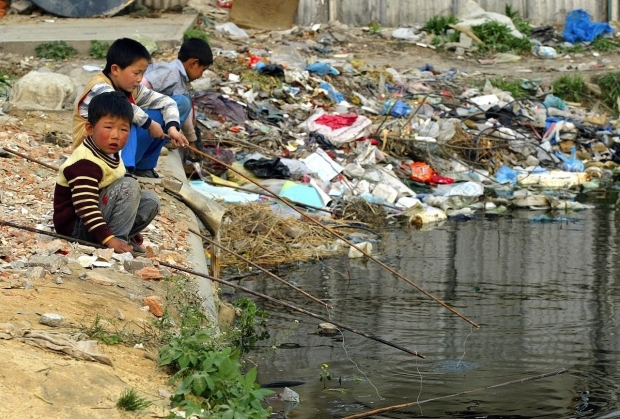Although China’s air pollution keeps making headlines, its water pollution is just as urgent a problem. One-fifth of the country’s rivers are toxic, while two-fifths are classified as seriously polluted. In 2012, more than half of China’s cities had water that was “poor” or “very poor.” Last week, China’s Ministry of Environmental Protection announced a trillion-yuan (U.S.$320 billion) plan to start dealing with this urgent issue.
The action plan, which is currently being drafted, will focus on curbing water pollution in the worst affected areas and preventing future pollution of the better conserved waters, Deputy Minister of Environmental Protection Zhai Qing said at a press conference.
Proposed measures reportedly include cutting industrial waste water discharge, improving sewage management in cities, and introducing better treatment for polluted water in rural areas.
“The situation of China’s water environment is still very grim,” the Deputy Minister said, quoting the figures of China’s annual volume of Chemical Oxygen Demand (COD) and ammonia nitrogen emissions, common indicators of water quality. The current annual volumes of the two is 24 million tons and 2.45 million tons respectively, Zhai said.
According to China Business News, China will have to reduce its annual volumes of COD and ammonia nitrogen emissions by 30-50% before there’s any significant improvement of its water.
Ma Jun, Director of the Institute of Public & Environmental Affairs, a Beijing-based green NGO, told chinadialogue that China’s waste water discharge has far exceeded the nation’s environmental bearing capacity and hence the incoming action plan is “very necessary”.
“Tackling water pollution is as serious and worthy a challenge for the authority as combating air pollution...water pollution poses a bigger health threat to about 300 million people living in rural areas, and many of them are vulnerable and disadvantaged,” Ma Jun said.
In June 2013, China’s national disease control authority confirmed that water pollution was responsible for the high cancer rates along the Huai River and its tributaries. Later in September, state news agency Xinhua reported that water pollution may be linked to the increase in cancer cases in more than 247 villages nationwide.
The worsening water pollution is fueling social discontent. On the same day that top environmental officials announced the action plan, the Associated Press reported that villagers in Southwestern Yunnan province had clashed with local police over a factory that was discharging waste water.
Though the action plan on water pollution aims to address public concerns over China’s deteriorating environment, it is not likely to see quick effects, experts have said.
“China’s water pollution is the byproduct of three decades’ rapid economic development. There is no doubt that the action plan will speed up the improvement of water quality, but it will take a very long time before any fundamental improvement occurs,” said Fu Tao, a water governance expert at Tsinghua University, in an interview with China Business Radio.
Ma Jun echoed Fu’s opinion by saying that water is more difficult to clean up than air. “The cleaning process will take longer and cost more, especially when the polluted water has entered the underground water circle,” he said.
“But we can borrow experience from the anti-air pollution campaign. Disclosing information, encouraging public participation, identifying pollution sources, and reducing waste water discharges are all good places to start.”




